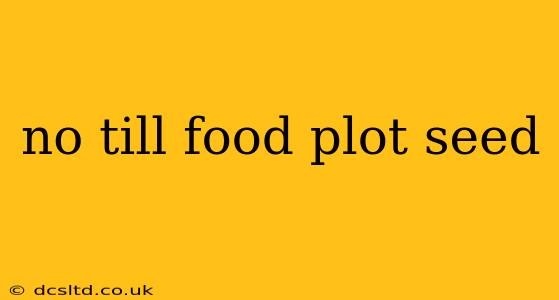No-till food plots offer a revolutionary approach to wildlife habitat management, eliminating the need for disruptive and soil-damaging tillage. This method not only saves time and effort but also boasts numerous environmental benefits, promoting soil health, reducing erosion, and improving water infiltration. Choosing the right no-till food plot seed is crucial for success, and this guide will equip you with the knowledge to make informed decisions and establish thriving food plots.
What is No-Till Food Plotting?
No-till food plotting involves planting seeds directly into existing vegetation without plowing or tilling the soil. This technique leverages specialized seed drills or broadcasting methods, minimizing soil disturbance and preserving its natural structure. This approach is particularly beneficial for fragile soils prone to erosion, while also enhancing biodiversity and reducing compaction.
What are the Benefits of No-Till Food Plots?
The advantages of embracing no-till methods for food plots are substantial:
- Soil Health Improvement: No-till practices increase organic matter, improving soil structure and water retention.
- Erosion Control: Reduced soil disturbance minimizes erosion, particularly on slopes.
- Weed Suppression: Existing vegetation can help suppress weeds, reducing competition for nutrients.
- Time and Cost Savings: No-till planting requires less equipment and labor compared to traditional tillage.
- Increased Biodiversity: A diverse mix of native plants fosters a more robust and resilient ecosystem.
What Types of No-Till Food Plot Seeds are Available?
Selecting the right seed mix is paramount to a successful no-till food plot. Consider these factors:
- Species Selection: Choose species known for thriving in no-till conditions. Forbs (broadleaf plants) and legumes (nitrogen-fixing plants) often perform well. Popular choices include clover (white clover, crimson clover), chicory, brassicas (rape, turnips), and various native grasses.
- Seed Mixes: Pre-made no-till food plot seed mixes are readily available and offer balanced combinations of species tailored to specific regions and wildlife preferences. These mixes often include a blend of forbs, legumes, and grasses.
- Seed Quality: Ensure your seeds are high-quality, viable, and from a reputable supplier.
How to Plant No-Till Food Plot Seeds?
The planting method significantly impacts success. These options exist:
- No-Till Drill: These specialized drills are designed to penetrate existing vegetation and deposit seeds at the optimal depth, ensuring proper germination.
- Broadcast Seeding: This method involves scattering seeds over the surface, followed by light harrowing or rolling to improve seed-to-soil contact. This is often less effective than using a drill but can be more economical for smaller plots.
- Interseeding: This involves planting seeds into an existing stand of vegetation, allowing the new plants to establish alongside the existing ones.
What are the Challenges of No-Till Food Plotting?
While no-till offers numerous benefits, understanding potential challenges is crucial:
- Competition from Existing Vegetation: Established vegetation can compete with newly planted seeds for resources. Proper seed selection and planting techniques are vital to overcome this challenge.
- Seed-to-Soil Contact: Achieving sufficient seed-to-soil contact is crucial for germination. Appropriate techniques such as harrowing or rolling can improve this.
- Weed Control: While existing vegetation can suppress some weeds, careful monitoring and potential spot treatment may be necessary.
What are the Best No-Till Food Plot Seeds for Deer?
Deer are highly adaptable and readily consume a variety of forbs and legumes, including clovers, brassicas, and chicory. Mixes tailored to deer often include these, complemented by grasses like ryegrass or oats for added nutrition.
Can I Use a No-Till Drill for Small Food Plots?
Yes, smaller no-till drills are available, making this technique suitable even for smaller food plots. However, broadcasting seeds can also be effective for smaller areas.
How Much Seed Do I Need for a No-Till Food Plot?
Seed requirements vary depending on the species, planting method, and soil conditions. Refer to the seed mix instructions for recommended seeding rates.
When is the Best Time to Plant No-Till Food Plot Seeds?
Optimal planting times vary by region and species. Consult local resources and seed mix guidelines for specific recommendations, but generally, spring and fall are common planting seasons.
By understanding the benefits, challenges, and techniques involved in no-till food plotting, you can create thriving wildlife habitats that support a flourishing ecosystem while promoting sustainable land management practices. Remember to research the best species for your location and always prioritize seed quality and proper planting techniques for optimal results.
